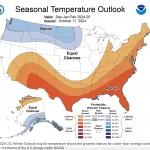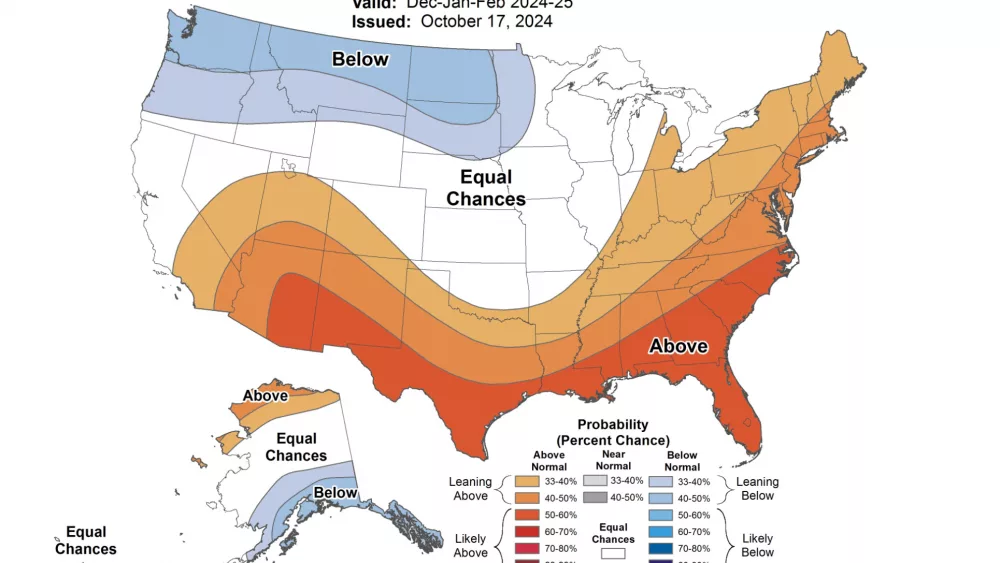
KANSAS CITY —A slowly-developing La Nina is favored to influence conditions for the upcoming winter across most of the country, according to NOAA’s U.S. Winter Outlook released today by the Climate Prediction Center — a division of NOAA’s National Weather Service. This outlook is for December 2024 through February 2025 and contains information on likely conditions throughout the country for temperature, precipitation and drought.
This winter, NOAA predicts wetter-than-average conditions for the entire northern tier of the continental U.S., particularly in the Pacific Northwest and the Great Lakes region, along with northern and western Alaska. Meanwhile, drier-than-average conditions are expected from the Four Corners region of the Southwest to the Southeast, Gulf Coast and lower mid-Atlantic states.
“In September, we announced a $100 million investment into NOAA’s high-performance computer system to advance research on weather, climate and ocean predictions because understanding our climate system is essential for making longer-term predictions like the Winter Seasonal Outlook, which provides vital information for many of our partners and the public,” said Michael Morgan, Ph.D., NOAA’s assistant secretary of commerce for observation and prediction. “We continue to innovate in this space, developing new ways to share winter forecast information with the public.”
“This winter, an emerging La Nina is anticipated to influence the upcoming winter patterns, especially our precipitation predictions,” said Jon Gottschalck, chief of the Operational Prediction Branch of the Climate Prediction Center.
La Nina conditions are expected to develop later this fall and typically lead to a more northerly storm track during the winter months, leaving the southern tier of the country warmer and drier. As a result, NOAA forecasters, in collaboration with the National Integrated Drought Information System (NIDIS), expect drought conditions to persist and worsen across the central and southern Plains of the U.S.
“Unfortunately, after a brief period in the spring of 2024 with minimal drought conditions across the country, more than a quarter of the land mass in the continental U.S. is currently in at least a moderate drought,” said Brad Pugh, operational drought lead with NOAA’s Climate Prediction Center. “And the winter precipitation outlook does not bode well for widespread relief.”
Temperature
- Warmer-than-average temperatures are favored from the southern tier of the U.S. to the eastern Great Lakes, eastern seaboard, New England and northern Alaska. These probabilities are strongest along the Gulf Coast and for most of Texas.
- Below-average temperatures are most likely in southern Alaska, with below-average temperatures slightly favored from the Pacific Northwest to the northern High Plains.
- The remaining areas have equal chances of below-, near-, or above-average seasonal mean temperatures.

Precipitation
- Wetter-than-average conditions are most likely in the Great Lakes states, and above-average precipitation is also favored in northern and western Alaska, the Pacific Northwest and across the northern tier of the U.S. These probabilities are strongest in portions of Ohio, Indiana and Kentucky.
- The greatest likelihood for drier-than-average conditions are in states bordering the Gulf of Mexico, as well as in Texas and southern New Mexico.
- Much of California, the central Plains states and the I-95 corridor from Boston to Washington, D.C., have equal chances of below-average, near-average or above-average seasonal total precipitation.

Drought
- Widespread moderate to extreme drought continues across much of the Great Plains and in portions of the Rocky Mountains, especially farther south.
- Drought conditions are expected to improve or end in the Ohio River Valley, the Great Lakes region and portions of the northwestern U.S., including eastern Washington and Oregon and northern and central Idaho.
- Drought conditions are expected to persist across the Great Plains.
- Drought is likely to develop or worsen across portions of the Southwest and Gulf Coast.
Winter forecasting tools: Here’s what’s new at NOAA
- Over the past year, NOAA implemented several upgrades and improvements to its forecasting tools. In late 2023, the experimental Probabilistic Winter Storm Severity Index (WSSI-P) became operational. The product enhances communication with external partners, media and the public by visually representing the likelihood of potential societal impacts due to expected winter hazards over a 7-day period. This is complemented by an existing operational version of the Winter Storm Severity Index (WSSI), which is based on the official National Weather Service forecast of the most likely conditions over the next three days.
- NOAA is simplifying its suite of cold weather products to improve messaging of these hazards and provide better decision support services. As of October 2024, the Wind Chill Watch, Warning, and Advisory products were consolidated into the Extreme Cold Watch and Warning and Cold Weather Advisory products, respectively. The Hard Freeze Watch and Warning products were consolidated into the existing Freeze Watch and Warning products, respectively. More information can be found within this hazard simplication project webstory.
- NOAA will make the Experimental Probabilistic Precipitation Portal publicly available beginning in early November. This webpage will enable users to view the Low-End, Expected and High-End amounts of snow and rain, as well as probabilities of exceeding threshold amounts of precipitation. Data will be available through an interactive map, tables and graphics to assist local partners, including emergency management, with decision support.
About NOAA’s seasonal outlooks
NOAA’s seasonal outlooks provide the likelihood that temperatures and total precipitation amounts will be above-, near- or below-average, and how drought conditions are anticipated to change in the months ahead. The outlook does not project seasonal snowfall accumulations as snow forecasts are generally not predictable more than a week in advance.
NOAA’s Climate Prediction Center updates the three-month outlook monthly. The next update will be available November 21.
Seasonal outlooks help communities prepare for what is likely to come in the months ahead and minimize weather’s impacts on lives and livelihoods. Resources such as drought.gov and climate.gov provide comprehensive tools to better understand and plan for climate-driven hazards. Empowering people with actionable forecasts, seasonal predictions and winter weather safety tips is key to NOAA’s effort to build a more Weather– and Climate-Ready Nation.





